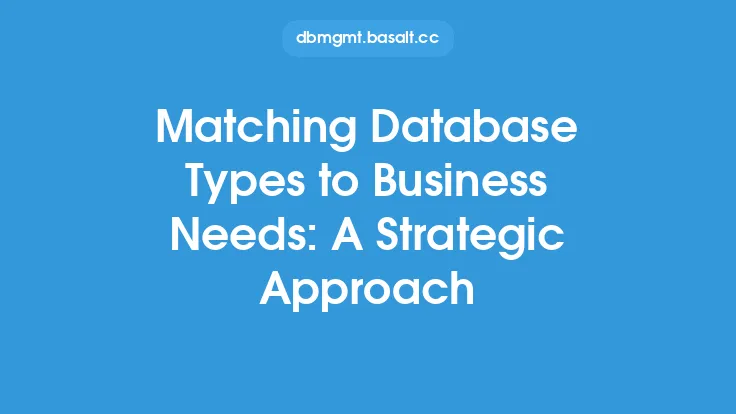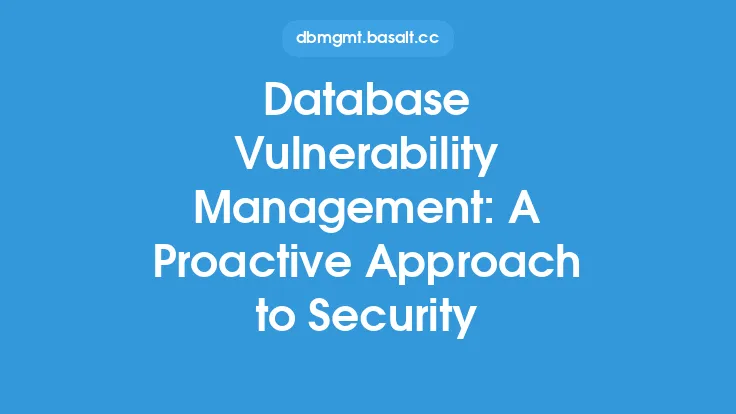When it comes to database performance troubleshooting, a statistics-based approach is essential for identifying and resolving issues efficiently. This approach involves collecting and analyzing various statistics and metrics to understand the database's behavior, identify bottlenecks, and optimize performance. In this article, we will delve into the world of database statistics and explore how they can be used to troubleshoot performance issues.
Introduction to Database Statistics
Database statistics are numerical values that provide insight into the database's performance, usage, and behavior. These statistics can be collected at various levels, including the database, table, index, and query levels. Common database statistics include query execution times, disk usage, memory usage, CPU utilization, and network traffic. By analyzing these statistics, database administrators can identify trends, patterns, and anomalies that may indicate performance issues.
Types of Database Statistics
There are several types of database statistics that can be collected and analyzed, including:
- Query statistics: These statistics provide information about query execution times, query plans, and resource usage. Query statistics can help identify slow-running queries, optimize query plans, and reduce resource contention.
- System statistics: These statistics provide information about system resources, such as CPU utilization, memory usage, and disk usage. System statistics can help identify resource bottlenecks, optimize system configuration, and improve overall system performance.
- Storage statistics: These statistics provide information about storage usage, such as disk space, I/O rates, and storage latency. Storage statistics can help identify storage bottlenecks, optimize storage configuration, and improve data retrieval performance.
- Network statistics: These statistics provide information about network traffic, such as packet rates, latency, and throughput. Network statistics can help identify network bottlenecks, optimize network configuration, and improve data transfer performance.
Collecting Database Statistics
Collecting database statistics is a crucial step in the troubleshooting process. There are several ways to collect database statistics, including:
- Built-in database tools: Most databases come with built-in tools for collecting statistics, such as SQL Server's Dynamic Management Views (DMVs) or Oracle's Automatic Workload Repository (AWR).
- Third-party tools: Third-party tools, such as database monitoring software, can provide more detailed and comprehensive statistics than built-in tools.
- Custom scripts: Custom scripts can be written to collect specific statistics or to collect statistics at regular intervals.
Analyzing Database Statistics
Analyzing database statistics requires a combination of technical skills, knowledge of database internals, and experience with performance troubleshooting. When analyzing database statistics, it's essential to:
- Identify trends and patterns: Look for trends and patterns in the statistics to identify potential issues.
- Compare to baselines: Compare the statistics to baseline values to identify deviations from normal behavior.
- Correlate with other data: Correlate the statistics with other data, such as system logs or application logs, to identify potential causes of issues.
- Drill down into details: Drill down into detailed statistics to identify specific causes of issues.
Common Database Performance Issues
Some common database performance issues that can be identified using a statistics-based approach include:
- Slow query performance: Slow query performance can be identified by analyzing query execution times, query plans, and resource usage.
- Resource contention: Resource contention can be identified by analyzing system statistics, such as CPU utilization, memory usage, and disk usage.
- Storage bottlenecks: Storage bottlenecks can be identified by analyzing storage statistics, such as disk space, I/O rates, and storage latency.
- Network bottlenecks: Network bottlenecks can be identified by analyzing network statistics, such as packet rates, latency, and throughput.
Best Practices for Database Statistics Collection and Analysis
To get the most out of a statistics-based approach to database performance troubleshooting, it's essential to follow best practices for database statistics collection and analysis, including:
- Collect statistics regularly: Collect statistics at regular intervals to identify trends and patterns.
- Store statistics historically: Store statistics historically to compare current behavior to past behavior.
- Use automated tools: Use automated tools to collect and analyze statistics to reduce manual effort and improve accuracy.
- Correlate with other data: Correlate statistics with other data, such as system logs or application logs, to identify potential causes of issues.
Conclusion
A statistics-based approach to database performance troubleshooting is a powerful tool for identifying and resolving performance issues. By collecting and analyzing various database statistics, database administrators can identify trends, patterns, and anomalies that may indicate performance issues. By following best practices for database statistics collection and analysis, database administrators can improve the efficiency and effectiveness of their troubleshooting efforts and ensure optimal database performance.





